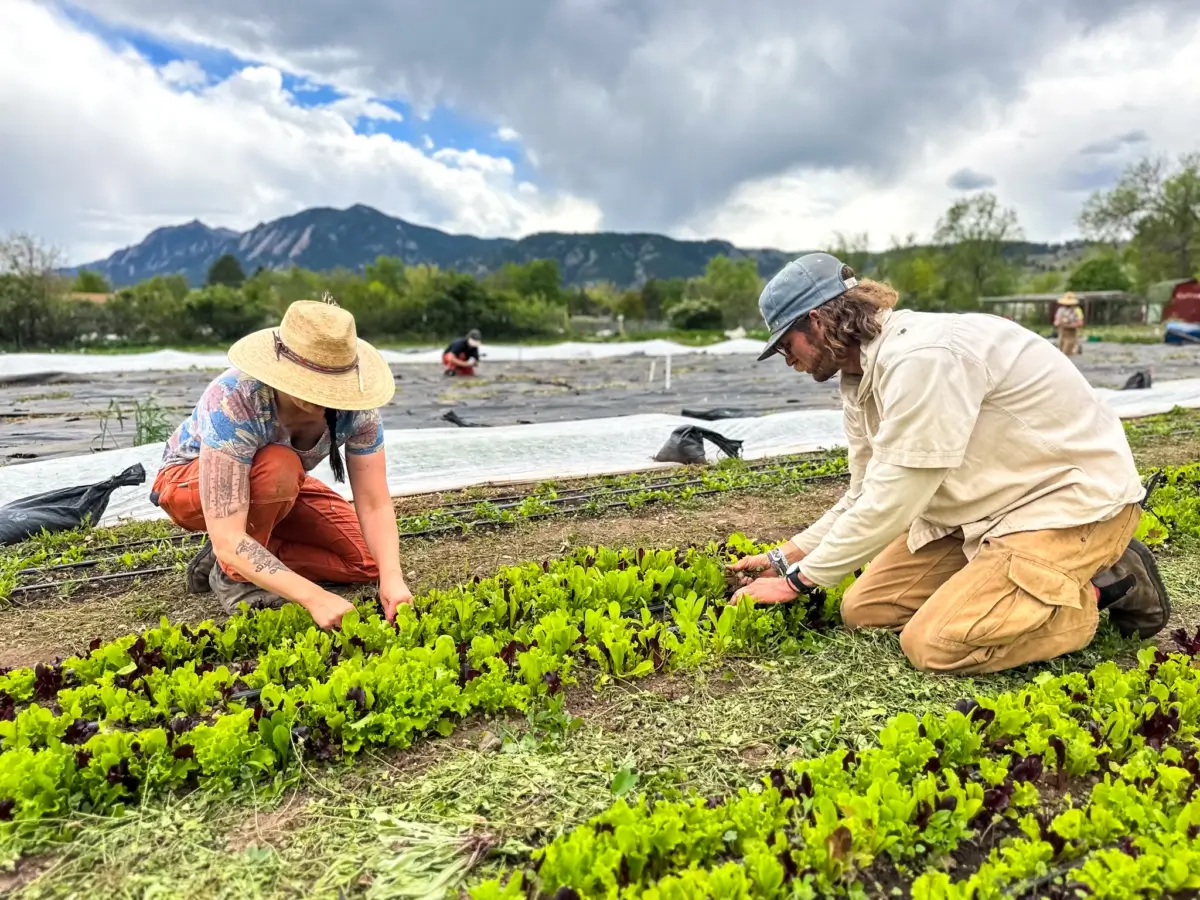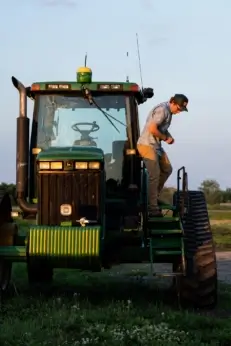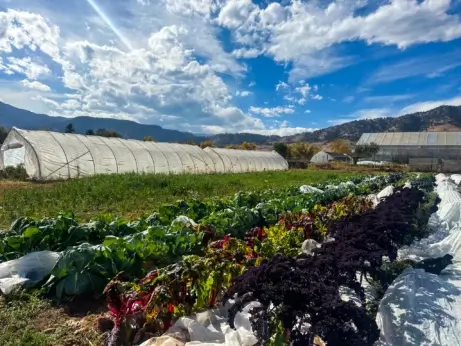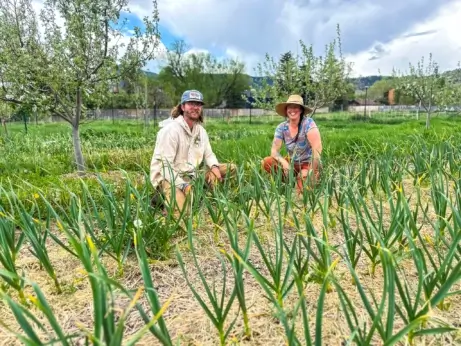We Need Regenerative Agriculture, But How Can Farmers Fund the Transition?
“It’s always us asking the question of what do we want to do? And then going out and trying desperately to find some money to offset the capital that it takes to run a farm.”
We Need Regenerative Agriculture, But How Can Farmers Fund the Transition?
“It’s always us asking the question of what do we want to do? And then going out and trying desperately to find some money to offset the capital that it takes to run a farm.”

Growing Gardens, a non profit community farm in Boulder CO, specializing in regenerative agriculture education.
“Of 400 farms in our county, only five are organic,” says Matt Fitzgerald of Fitzgerald Organics in Hutchinson, Minnesota. His 2,500-acre family farm is patchwork across 40 miles of land the family owns and leases, and grows organic corn, soy, wheat and specialty crops such as beans and peas.
Getting funding to transition to regenerative organic practices can be a challenge for farms of all sizes, but it’s a necessity if we want to have abundant harvests for generations to come.
Fitzgerald says that while the farm mainly works with a community bank, the lenders don’t understand its operations to accurately assess risk of organic and regenerative farming operations. Plus, Fitzgerald explains that the typical bank is looking to lend only a 12- to 18-month credit. This can put regenerative farmers in a bind as it takes multiple years to transition land or reach profitability with new processes.
There is never a silver bullet solution to any environmental issue. Regenerative agriculture in practice looks different depending on the unique situation of the farm, and so does the funding for it.

Multi-year credit helps established farms
Recently, Fitzgerald Organics acquired 140 acres of farmland, and needed financing to transition the plots to organic, as well as implement cover crops and plant pollinator strips. In the first year, the farm grew yellow peas as a transition crop and had a hail event that wasn’t covered by crop insurance in Minnesota. Then it grew winter wheat in the second year, which isn’t as profitable as other crop types.
“Historically, when we’ve transitioned farms, we’ve just eaten those losses annually,” says Fitzgerald. But the farm developed a partnership with Mad Agriculture, which helps farmers get access to the resources and knowledge they need to implement regenerative practices. One of four branches of the MAD! ecosystem is Mad Capital, a private investment firm that finances regenerative farmers.
Fitzgerald emphasized that Mad Capital’s model of lending multi-year credit with the choice of interest-only or revenue-based repayment relieved pressure and enabled him to keep going despite challenges.

“All we do is work with organic farmers. We understand the risk. We understand the challenges and the types of capital it takes to facilitate [a regenerative] transition,” says Brandon Welch, co-founder and CEO of Mad Capital. “We know on the other side of that, there’s a positive return.”
To date, Mad Capital has supplied more than 30 farmers across 15 states growing on more than 79,000 acres with $25 million in loans for operating expenses, new equipment, real estate and expansion and regenerative transition expenses.
“We really listen to the needs of the land and the farmer in a way that most companies just don’t,” says Philip Taylor, co-founder and executive director of Mad Agriculture.
He highlights that they seek to accelerate the process for farmers who already care about sustainability. “Somewhere between 10 million and 20 million acres is, we believe, possibly a tipping point where regenerative organic ag could become inevitable,” says Taylor.
And they’re ready to fund more farmers. Mad Capital recently announced a $50-million investment round for its Perennial Fund II, with investor commitments from the likes of the Rockefeller Foundation, Builders Vision, Lacebark Investments and nearly a dozen others.
But not every farm is the right candidate for a loan. Luckily, more avenues for funding exist.
Using corporate dollars
“Food and even fashion companies who source from agriculture have realized that, to meet their environmental and social commitments, they need to work with their farmers,” says Lauren Dunteman, senior associate of Regenerative Supply at Terra Genesis, a consultancy helping brands source from regenerative agriculture.
Sourcing can significantly impact sustainability outcomes for brands. But for this approach to work, there must be transparency, says Dunteman. “Farmers don’t always know where their crops go, and brands don’t know what farms their crops come from.” That issue prompts brands to fund regenerative practices either directly or indirectly.
If a brand can’t trace ingredients to the farm level, it may pick any farm or group of farmers and fund their regenerative practices. But if it knows its farmers and can directly invest in regenerative practices, it has options, such as:
Including producers from the beginning and honoring traditional knowledge is key to the success of initiatives like this. “There needs to be a shift in power dynamics,” says Dunteman. “Less dictating to producers and more collaboration.”
Timberland, Vans and The North Face are able to support and source regenerative rubber through partnering with Terra Genesis. These brands now pay a premium to rubber farmers who grow using traditional methods that include diverse agroforestry systems and ecological management practices, which incentivizes other farmers to return to growing in this way.
Dunteman highlights another avenue that exists to support farmers who make the effort to adopt regenerative practices: paying to license their climate and environmental outcome data. Farmers gain an additional revenue stream, and brands are able to prove their environmental progress.
This approach to data sovereignty is being used by Ethos, which Dunteman’s team uses to verify regenerative outcomes. Consumers can look for the Ethos Verified Regenerative label to know they’re supporting sustainability with their purchases.
While this funding approach is creative and helps engage consumers in sustainability when done right, how do small local farms who sell direct to consumers—not to brands—access the funding they need?
Small farms and conservation grants
“It’s been incredibly frustrating,” says Lauren Kelso, site director at nonprofit community farm Growing Gardens and the policy chair for Flatirons Farmers Coalition, a chapter of the National Young Farmers Coalition [NYFC]. “I just couldn’t believe the red tape involved, the number of conversations we had to have and then what the payments were.”

She says there are federal and state grant programs available for conservation and soil health initiatives, but they often benefit larger farms with massive acreage and the resources to submit a great application and measure outcomes. Beginning farmers may not have the time or grant writing skills to successfully secure funding. Plus, she notes that many farmers with Indigenous or cultural practices are overlooked, as holistic land stewardship doesn’t always fit the mold of what funding agencies look for.
Kelso has talked to a lot of other farmers in NYFC and asked if they use these programs. Practically everyone was frustrated at the time and effort it took and the low payments they got in the end.
“These are farmers that are living month to month,” says Kelso, “and they were still turning down the opportunity to get funding to offset the cost of their practices. That’s really telling to me.”
Many programs available only give a certain amount—such as a couple of dollars—per acre to fund conservation initiatives. If you’re only farming on a few acres, it’s not worth all the time it takes to submit a grant application. She notes that one of the better options is the Conservation Stewardship Program (CSP) through the NRCS. It grants long-term cost share contracts for soil health practices and recently increased its minimum payment to $4,000 per year for smaller farms, making it worth the effort to apply.
Kelso mentions the Colorado Department of Agriculture STAR program as a good option for farmers, and one that more states should use as a model. It’s a three-year funding program with a minimum payment for small producers that requires farms to work with a technical assistance provider such as Mad Agriculture or conservation district staff.
With conventional agriculture, we just take and never replenish. Regenerative practice means that farmers are obliged to re-invest in the land, which can mean lost income. If they are unable to cover costs through grants, small producers often counteract it by selling organic and regenerative products at a premium.
But there’s only so much the consumer market can pay for, especially considering how many people are stressed about grocery inflation. “There’s a fundamental misunderstanding about what the market should be responsible for versus what [farmers] need public support with,” says Kelso.
Holistic support
Aside from Mad Capital, there are a handful of other organizations investing in sustainable farms, such as the Savanna Institute or Slow Money. Farming coalitions or industry organizations can also de-risk transitions for local producers by purchasing tools and equipment that farms can rent on an as-needed basis, such as the Flatirons Young Farmer’s Coalition Tool Library.
And peer-to-peer learning is of utmost importance. Many farmers who switch to regenerative methods have to learn by trial and error, as they may be the first in their community to do things differently. Creating knowledge-sharing channels through local organizations or even state agriculture departments can help producers implement regenerative practices at scale more efficiently, spurring on a revolution that is necessary for a stable future.
Ultimately, we need a collage of holistic solutions tailored to farms of all sizes to provide resources, funding and long-term support for regenerative agriculture.
“We need to get clear on how much public good it does us to be growing in these ways,” says Kelso. “And we need to be OK paying for it.”

Follow us
This work is licensed under a Creative Commons Attribution-NoDerivatives 4.0 International License.
Want to republish a Modern Farmer story?
We are happy for Modern Farmer stories to be shared, and encourage you to republish our articles for your audience. When doing so, we ask that you follow these guidelines:
Please credit us and our writers
For the author byline, please use “Author Name, Modern Farmer.” At the top of our stories, if on the web, please include this text and link: “This story was originally published by Modern Farmer.”
Please make sure to include a link back to either our home page or the article URL.
At the bottom of the story, please include the following text:
“Modern Farmer is a nonprofit initiative dedicated to raising awareness and catalyzing action at the intersection of food, agriculture, and society. Read more at <link>Modern Farmer</link>.”
Use our widget
We’d like to be able to track our stories, so we ask that if you republish our content, you do so using our widget (located on the left hand side of the article). The HTML code has a built-in tracker that tells us the data and domain where the story was published, as well as view counts.
Check the image requirements
It’s your responsibility to confirm you're licensed to republish images in our articles. Some images, such as those from commercial providers, don't allow their images to be republished without permission or payment. Copyright terms are generally listed in the image caption and attribution. You are welcome to omit our images or substitute with your own. Charts and interactive graphics follow the same rules.
Don’t change too much. Or, ask us first.
Articles must be republished in their entirety. It’s okay to change references to time (“today” to “yesterday”) or location (“Iowa City, IA” to “here”). But please keep everything else the same.
If you feel strongly that a more material edit needs to be made, get in touch with us at [email protected]. We’re happy to discuss it with the original author, but we must have prior approval for changes before publication.
Special cases
Extracts. You may run the first few lines or paragraphs of the article and then say: “Read the full article at Modern Farmer” with a link back to the original article.
Quotes. You may quote authors provided you include a link back to the article URL.
Translations. These require writer approval. To inquire about translation of a Modern Farmer article, contact us at [email protected]
Signed consent / copyright release forms. These are not required, provided you are following these guidelines.
Print. Articles can be republished in print under these same rules, with the exception that you do not need to include the links.
Tag us
When sharing the story on social media, please tag us using the following: - Twitter (@ModFarm) - Facebook (@ModernFarmerMedia) - Instagram (@modfarm)
Use our content respectfully
Modern Farmer is a nonprofit and as such we share our content for free and in good faith in order to reach new audiences. Respectfully,
No selling ads against our stories. It’s okay to put our stories on pages with ads.
Don’t republish our material wholesale, or automatically; you need to select stories to be republished individually.
You have no rights to sell, license, syndicate, or otherwise represent yourself as the authorized owner of our material to any third parties. This means that you cannot actively publish or submit our work for syndication to third party platforms or apps like Apple News or Google News. We understand that publishers cannot fully control when certain third parties automatically summarize or crawl content from publishers’ own sites.
Keep in touch
We want to hear from you if you love Modern Farmer content, have a collaboration idea, or anything else to share. As a nonprofit outlet, we work in service of our community and are always open to comments, feedback, and ideas. Contact us at [email protected].by Lindsey Beatrice, Modern Farmer
May 28, 2024
Modern Farmer Weekly
Solutions Hub
Innovations, ideas and inspiration. Actionable solutions for a resilient food system.
ExploreExplore other topics
Share With Us
We want to hear from Modern Farmer readers who have thoughtful commentary, actionable solutions, or helpful ideas to share.
SubmitNecessary cookies are absolutely essential for the website to function properly. This category only includes cookies that ensures basic functionalities and security features of the website. These cookies do not store any personal information.
Any cookies that may not be particularly necessary for the website to function and are used specifically to collect user personal data via analytics, ads, other embedded contents are termed as non-necessary cookies.